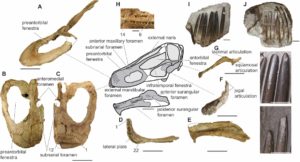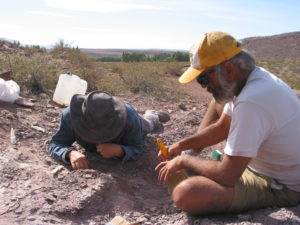PALEONTOLOGICAL FINDING
Argentine and Spanish paleontologists found an adult specimen and two juvenile specimens of this new species of dinosaur, which they named Lavocatisaurus agrioensis. They made an almost complete reconstruction of his skull and skeleton.
Dr. José Luis Carballido, researcher at the Egidio Feruglio Museum (MEF) and at the CONICET, pointed out to the Agencia CTyS-UNLaM that “it is not only the finding of a new species in a place where we did not expect to find fossils, but rather, In addition, the skull is practically complete.”
Lavocatisaurus agrioensis belongs to the group of sauropod dinosaurs, those quadruped herbivores of neck and long tail between which there were gigantic species that weighed more than 70 tons and other “dwarfs” that did not exceed 10 meters in length when reaching adulthood.
“We found most of the skull bones of the Lavocatisaurus: the snout, the jaws, a lot of teeth, also the bones that define the orbit of the eyes for example and, in that way, we were able to do a very complete reconstruction”, detailed Carballido, who, in 2017, presented to the world the largest dinosaur known to date: the Patagotitan mayorum.
In addition, part of the neck, tail and back of this animal were found. Dr. José Ignacio Canudo, researcher at the University of Zaragoza and lead author of the study, said that “in the case of Lavocatisaurus, we estimate that the adult specimen measured 12 meters, while juveniles were around 6 to 7 meters.”
“This discovery of an adult and two juveniles also meant the first record of a group displacement within the dinosaurs rebaquisáuridos”, added the paleontologist Canudo.
The finding occurred in the center of the province of Neuquén. Carballido described that “at that site, 110 million years ago, the environment was very desert, with sporadic lagoons, so we discarded finding fossils there; Although it is estimated that this group of sauropods could have been adapted to move in rather arid environments, with low vegetation, with little humidity and little water, it is an environment in which one would not be looking for fossils “.
The same aridity of the environment indicates that the fossil remains of these three specimens were not displaced and gathered next to a waterway, but that they moved in groups and died together. There is no way to know if there was kinship among the members of this group, so it will be left to the imagination to guess if it was a father or a mother with two of their children.
At that time, South America and Africa had not yet been separated. Therefore, dinosaurs rebaquisáuridos have been discovered in Africa and Europe. In fact, the first finding of a rebaquisáurido was made in the Sahara desert in 1950, by the paleontologist René Lavocat and, in honor of him, is that this new Neuquén species was named Lavocatisaurus.
A Spanish-Argentine team, composed of researchers José Ignacio Canudo (IUCA-University of Zaragoza), José Luis Carballido (MEF-CONICET), Alberto Garrido (MOZ – Neuquén) and Leonardo Salgado (UNRN-CONICET), conducted the study of Lavocatisaurus, published in the scientific journal Acta Palaeontologica Polonica.
Almost complete reconstruction of the Lavocatisaurus skull
Previously, in Nigeria, an almost complete skull was found within the group of rebaquisáurids. “The skull of the Lavocatisaurus is quite different, more basal and with more primitive characteristics”, explained Canudo to the Agency CTyS-UNLaM.
“Until the discovery of Lavocatisaurus, it was believed that the rebaquisáuridos had two facets of wear on their teeth, but here we clearly see a single facet of wear that, in no way, is the product of the friction of the upper teeth with the lower teeth, because the lower teeth are very small in relation to superiors, “explained the researcher at the University of Zaragoza.
Based on the observation of a facet of wastage on their teeth, the authors of the study of the Lavocatisaurus infer that this dinosaur had a kind of keratinous covering on the lower part of the skull with which it probably scraped the inner side of the upper teeth each time I wanted to cut the branches to feed.
From the almost complete finding of the skull, it is possible to see its elongated teeth in the shape of a pencil. Also, it is observed that their teeth had the thickest enamel layer on the outer side, that is, towards the lips; and that, in addition, they have a facet of low angle wear that would be caused by said keratinous structure.



